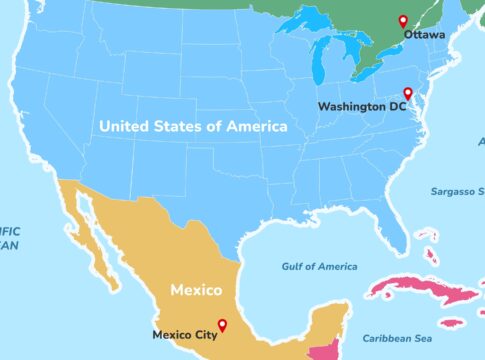Make a deal if they become the 51st state? Trump’s tariffs on Canada aimed at curbing border threats have ignited controversy as data contradicts claims about fentanyl trafficking between the two nations. President Trump has implemented a 25% tariff on all Canadian imports, with a 10% duty on energy resources, citing drug trafficking concerns. Data shows minimal fentanyl trafficking from Canada to the U.S., with less than 1% of seizures occurring at the northern border.
Trump’s Border Security Strategy
President Trump has moved forward with imposing tariffs on Canada and Mexico under the International Emergency Economic Powers Act (IEEPA), claiming these measures are necessary to combat national security threats from drug trafficking and illegal immigration. The tariffs include a 25% duty on all imports from these countries, with an additional 10% duty specifically on energy resources from Canada. The White House justified these actions based on what they describe as an urgent need to secure America’s borders.
Both Mexico and Canada received a one-month delay in implementation following their commitments to address the trafficking concerns. Prime Minister Trudeau of Canada announced this pause after direct communication with President Trump, creating a temporary reprieve for cross-border trade while both nations work toward resolving the dispute. The tariffs could significantly impact industries including automotive, energy, food, agriculture, and electronics on both sides of the border.
This is important to understand in regards to Donald Trump's tariffs.
There are immediate tariffs that are based on countries – Canada and Mexico securing the border to illegal immigration and fentanyl and then there are the tariffs that will be studied later (doubt they will… pic.twitter.com/I2yD7GlmAf
— Kirk Lubimov (@KirkLubimov) January 29, 2025
Contradictions in Fentanyl Claims
The justification for imposing tariffs on Canada appears contradicted by data regarding fentanyl trafficking. Government statistics show that less than 1% of fentanyl seizures occur at the northern U.S. border, with the vast majority coming from Mexico, not Canada. This discrepancy between the stated rationale and actual border security data has raised questions about the true motivation behind the tariffs, particularly as they affect America’s largest trading partner.
“There is no indication at all that any significant amount of fentanyl is coming to the United States from Canada.” – Vanda Felbab-Brown
Furthermore, President Trump’s claims about fentanyl “killing 250,000 to 300,000 American people per year” and White House statements about it having “killed tens of millions of Americans” have been disputed by health experts. Official data indicates that while fentanyl remains a serious public health crisis, these figures are significantly exaggerated, and recent trends actually show decreases in fentanyl deaths and smuggling.
Canada hitting the US with another 25% of tariffs, on about $30 billion of US imports into Canada, will not end well for Canada.
In the words of President Trump, “You don’t have the cards.”
Canada needs the US a lot more than vice versa.pic.twitter.com/cG6N3nNwds
— Paul A. Szypula 🇺🇸 (@Bubblebathgirl) March 12, 2025
Legal Questions and Economic Impact
Legal experts have raised serious concerns about the president’s use of the IEEPA to impose these tariffs. The Constitution grants Congress the sole power to regulate foreign commerce and impose tariffs, and critics argue that IEEPA does not explicitly grant tariff authority to the executive branch. The Supreme Court’s “major questions doctrine” suggests Congress would need to speak clearly if it intended to delegate such significant economic decisions to the president. However, when the legislative body is hesitant to move forward, the president will.
“Expects] Congress to speak clearly if it wishes to assign to an agency decisions of vast ‘economic and political significance'” – U.S. Supreme Court
The economic stakes are substantial. Canada has announced retaliatory 25% tariffs on US goods, setting up a potential trade war between the two nations. The United States-Mexico-Canada Agreement (USMCA), which supports significant trade and jobs on both sides of the border, is now threatened by these unilateral actions. American businesses that rely on Canadian imports face increased costs that may ultimately be passed on to consumers, while export-focused companies will likely suffer from Canada’s countermeasures.
Northern Border Realities
The U.S.-Canadian border stretches over 5,500 miles, making it the longest international land border in the world. Despite its length, illegal crossings from Canada are dramatically lower than those at the southern border. Last year, fewer than 24,000 crossings occurred at the northern border, a fraction of the activity seen along the U.S.-Mexico boundary. This statistical reality further undermines the national security rationale for imposing equal tariffs on both nations.
Some cartel operatives, however, view the northern border as an opportunity. A Sinaloa Cartel smuggler identified as “Javi” told 60 Minutes that regardless of Trump’s policies, “There’s always going to be business. Later on, Donald Trump’s time will pass, and this will continue. This is not going to stop.” This suggests that heightened enforcement in one area may simply shift smuggling operations to other routes rather than eliminating the problem entirely.


